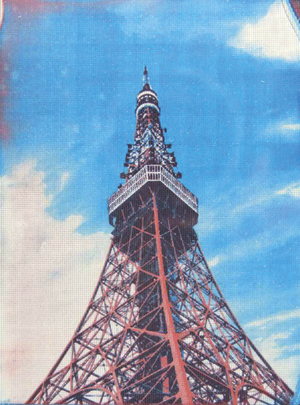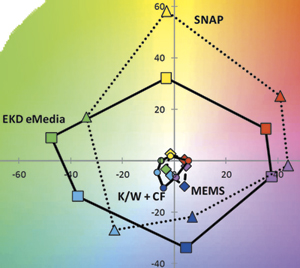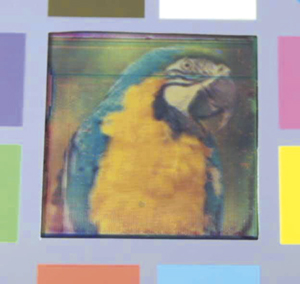Display Week 2012 Review: e-Paper
Major corporate bets are already placed, but new breakthroughs abound at the Symposium.
by Jason C. Heikenfeld
IN PERSPECTIVE, let's start this year's review of e-Paper at Display Week with the last few lines from my previous year's review (in the July/August 2011 issue of Information Display): "Looking forward to next year, will we have color modules from E Ink (electro-phoretic), Bridgestone (liquid powder), Qualcomm (mirasol), and Samsung (electro-wetting) in the marketplace? … Next year should be a critical one for accessing the ability of e-Paper to move beyond signage and e-Readers."
Well, this past year, both mirasol and initial color-electrophoretic modules did appear in limited distribution in a few markets, while Bridgestone exited the race and electrowetting progress has been ultra-quiet since Samsung acquired the technology. Just for evaluation purposes, I purchased an electrophoretic Jetbook color e-Reader and Mirasol Kyobo e-Reader. No one I have talked to believes they provide highly compelling color, but if battery life and sunlight readability are important, and you need color and/or video content displayed, then they of course look much better than an iPad would in sunlight – or with a dead battery! Qualcomm remains tenacious in pushing mirasol into the market; the key question is whether the company can achieve the volume of sales needed to justify the billions of dollars it has invested.
Last year, my article was highly fixated on color and video – maybe too much. We should not forget the continued success of monochrome e-Readers and the strong growth in applications such as electronic shelf labels. However, rather than continue to speculate on where we are today or where we are heading next, let's instead turn our attention to what I actually saw at Display Week this year. There were examples of exciting R&D progress, which I'll get to, but first I'll cover the relatively more mature technologies.
On the exhibition floor, the demonstrations were mostly of technologies seen in the past, with even a few expected developments missing. For example, the E Ink prototypes were expanded in types of applications shown (more shelf-labels/signage for example), but R&D demos with significantly higher reflectivity than last year were absent (see Fig. 1 for a look at just some of the many modules on display at E Ink's booth).

Fig. 1: Walls of monochrome and color electrophoretic modules were on display at the E Ink booth, demonstrating that the expansion of applications for this technology continues. Photo courtesy the author.
E Ink's progress toward animation and video continues. The video demos sneak in visually obvious reset frames after several video frames, and display expert Ken Werner summed it up best: "For kids' cartoons, the motion was smoother than I would have expected, but you could tell that at this point it costs them a significant loss in contrast."
Qualcomm was showing somewhat improved mirasol video-rate modules, with statements of improved performance that I cannot confirm or validate, only quote: "a 5.7-in. enhanced XGA display – this is the core in the four commercially launched products, but with doubled contrast ratio, improved brightness and color saturation, frame rate (continual 30 fps), and energy efficiency that would increase battery life by about 20% (to almost one month)." mirasol was awarded the Display of the Year Silver Award at the show, in recognition of commercial advances in sunlight readability and reduced power consumption.
For a second year, Opalux was exhibiting its photonic ink or P-Ink technology. This technology shows a clever advantage that it shares with other electrochemical-type displays (such as electrochromic), integration with RFID, which leverages the extremely low-voltage and current-driven nature of such devices (Fig. 2). One has to remember that screen performance is important, but ease of design into various products/devices can be a compelling advantage as well. Another great example is electrochromism in smart cards; they can be integrated as manufacturers prefer, using hot lamination. (For more about the P-Ink technology, see "Photonic-Crystal Display Materials" in the July/August 2011 issue of Information Display.)

Fig. 2: Opalux photonic crystal ink is electrochemically actuated using voltage low enough for RFID powering. Photo courtesy the author.
Overall this year, the e-Paper exhibits were certainly worthwhile to gauge the existing pulse of commercial and near-commercial technology. In general, you could argue in some respects that it was also a somewhat disappointing year on the commercialization end. In addition to the Bridgestone exit of liquid-powder technology, one of the great advantages and hopes for e-Paper seems to be stalled out: rollable displays. Polymer Vision, which has shown perfect-looking rollable monochrome rollable/foldable displays for some time now, is downsizing and in need of investors yet again. Hopefully by the time this article hits the press, the company will be back on-track financially. Furthermore, this spring Plastic Logic announced another delay and pull-back in commercialization of tablets and e-textbooks. The company is instead focusing on industrial and other uses for its flexible screens, in areas where a flexible, durable, and low-power display might command greater margin. Again, on the product end we may need to be satisfied for the time being with existing simple monochrome success. After all, E Ink continues to expand its R&D workforce, to the point where it has had to move to a new, larger facility near Boston. So where to go from here?
If you were looking for excitement, I hope you did not miss the Symposium, which was well worth the trip to Display Week on its own. There were numerous papers describing real leaps (not increments) in reflective brightness and saturated color. Fuji Xerox presented a multi-color particle CMY subtractive electrophoretic display that showed dramatically improved color. Naoki Hiji of Fuji, a long-time SID presenter known for his unique innovative approaches to e-Paper, gave the talk. His author-interview session had a live demo unit [Fig. 3(a)] and was extremely crowded, with viewing opportunities only available to those patient and athletic enough to slowly nudge/cram their way to the front. However, the wait to see the prototype was worth it; it looked as colorful as billed [Fig. 3(b)] and was remarkably functional for a first active-matrix prototype. The improvement over conventional side-by-side RGBW color filter is obvious and significant.
 (a)
(a)
 (b)
(b)
Fig. 3: (a) Zoom-out and (b) zoom-in photos show Fuji-Xerox's multi-colored particle EPD demonstrator using red/cyan particles. The improvement over the conventional RGBW approach was visually striking. Photo (a) courtesy the author. Photo (b) courtesy Fuji Xerox.
The prototype was only for red/cyan color, with single-pixel full-CMY-color operation reported in the Digest paper. The display had 30% reflectance and showed color over 100% of the area instead of 25% of the area for RGBW. I was particularly impressed with the quality of the black state for a first demo; however, getting a good black with additional mixed colors might require a lot of work. I hope to see the full-color version next year. Deservedly, this paper "Novel Color Electro-phoretic e-Paper Using Independently Movable Colored Particles" received a coveted Distinguished Paper Award from SID.
All of a sudden, there is very strong momentum in CMY subtractive color generation for e-Paper. It has always been known that this is theoretically the most likely approach to achieve bright and colorful e-Paper, but working pixel designs were lacking in the past. This is rapidly changing. For example, just last year Ricoh showed at Display Week a breakthrough CMY electro-chromic module. The Fuji electrophoretic and Ricoh electro-chromic CMY modules also share a major breakthrough; they can operate using a single active-matrix backplane. Even though their pixel physics are very different, they also both use a 4-cycle clear/write frameset to build the image. Because they require only a single active-matrix backplane, achieving high resolution and low cost is a real possibility.
Advances in CMY subtractive color e-Paper were also presented by Hewlett-Packard for three layers of active-matrix modules stacked together. Such an approach is clearly limited to low resolution, but the color performance can be quite compelling for billboards and signage. HP's title for its paper and talk was bold but said it all: "Ultra-Low-Power Reflective Display with the World's Best Color." Each active-matrix layer has 0.5-mm pixels with a 94% clear aperture. Each of the three layers compacts or spreads C, M, or Y pigments through electrokinetics. The color performance for both in- and off-axis lighting is very close to SNAP (Specifications for Newsprint Advertising Production) standards and the color is entirely in another league compared to RGBW on electrophoretic or mirasol [Figs. 4(a) and 4(b)]. However, it is important to remember that this performance is limited to medium- and low-resolution displays. HP's rapid technical progress in electrokinetic technology has been tremendous. The technology may be approaching the next hurdle of commercial adoption.
 (a)
(a)
 (b)
(b)
Fig. 4: HP's progress in color e-Paper is evidenced by (a) a plot of maximum color space compared to existing approaches such as RGBW E-Ink or RGB MEMS (Qualcomm mirasol) and (b) a working prototype surrounded by high-quality color printing on paper.
One way to improve the performance of more conventional RGBW displays is simply to find the best black/white shutter – hopefully one that demonstrates video speed since none of the hot CMY approaches can do video. So, turning attention back to single-layered monochrome (which, after all, is the only widely accepted e-Paper product), I gave an invited presentation on a new "electro-fluidic imaging film" that can be laminated like E Ink, switches at 12 msec, and is calculated to provide >80% white reflectance. This is a highly novel approach, partly because it is the first fluid or colorant-moving display that operates with no pixel borders or ink encapsulation. If an RGBW color filter is placed on this, it would be as bright as the widely accepted monochrome E Ink but with the addition of color and video. In fairness, however, I have to mention that this approach is brand new (less than a year old), is still causing my students and me sleepless nights just like a newborn baby would, and remains in development with regard to attributes such as gray-scale generation. My talk did lead to many interesting discussions, especially with the numerous companies accustomed to the ease of lamination integration of E Ink.
Outside the exhibit and Symposium, it was encouraging to see strong attendance at the 90-minute e-Paper seminars on Monday (I gave one on the present and future prospects for electronic paper; Russel Martin from Qualcomm gave one on displays for e-Readers). Also, it was encouraging that Janglin Chen, Vice President of Industrial Technology Research Institute (ITRI) in Taiwan, and the General Director of ITRI's Display Technology Center, was given a Special Recognition Award from SID "For his leading contributions to the development of hybrid plastic substrates for flexible displays and electronics and for the development of rewritable and reusable electronic paper." AUO presented a nice poster on an e-Paper module with a photovoltaic integrated on the back side. Some implementations of e-Paper are indeed so power efficient that plugs for charging are not needed.
As always, it is impossible to cover all the e-Paper seen at Display Week 2012 in this brief article. The diversity of players in the e-Paper race remains large, with a few companies leaving, and a few new ones entering. However, e-Paper is still only widely available in monochrome formats. Clear needs are improved black/white shutters that can allow video rate and high-resolution RGBW color displays. Another clear need is non-video-rate but excellent reflective color, for which CMY approaches are rapidly taking the performance lead. After this year passes, we will again be wiser on how e-Paper stacks up commercially as e-Paper continues to grow in existing monochrome applications, while its developers seek a way to break out the technology into large-volume color e-Paper products for signage and video-speed tablets. •